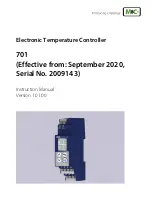
2.2 b: Application
YASKAWA ELECTRIC
TOEP C710687 03B FSDrive-MV1000 Parameter Guide
115
n
b3-35: Software CLA Current Limit Value 2 during Speed Search
Sets the current limit value for the software a percentage of the motor rating when the frequency reference is 0 to 6 Hz
during Speed Search.
u
b4: Delay Timers
The timer function is independent of drive operation and can delay the switching of a contact output triggered by a
contact input signal and help eliminate chattering noise from sensors. An on-delay and off-delay can be set separately.
To enable the timer function, a contact input must be set to “Timer input” (H1-
=18) and a contact output must be set
to “Timer output” (H2-
=12). Only one timer can be used.
n
b4-01, b4-02: Timer Function On-Delay, Off-Delay Time
Parameter b4-01 sets the on-delay time for switching the timer output. Parameter b4-02 sets the off-delay time for
switching the timer output.
n
Timer Function Operation
The timer function switches on when the timer function input closes for longer than the value set in b4-01. The timer
function switches off when the timer function input is open for longer than the value set in b4-02. The following diagram
demonstrates the timer function operation:
Figure 2.14
Figure 2.14 Timer Operation
u
b5: PID Control
The PID controller matches the feedback value (detected value) to the target value. Proportional (P), Integral (I), and D
(Derivative) combination control is also available for machinery applications in which a loss time occurs.
n
P Control
The output of P control is the product of the deviation and the P gain so that it follows the deviation directly and linearly.
With P control, only an offset between the target and feedback remains.
n
I Control
The output of I control is the integral of the deviation. It matches the feedback value to the target value. When the target
value changes rapidly, this control is lost.
n
D Control
D control predicts the deviation signal by multiplying its derivative (slope of the deviation) by a time constant, then adds
this value to the PID input. This way the D portion of a PID controller provides a braking action on the controller
response and can reduce the tendency to oscillate and overshoot.
D control tends to amplify electrical interference on the deviation signal, which can result in control instability. Only use
D control when absolutely necessary.
No.
Name
Setting Range
Default
b3-35
Software CLA Current Limit Value 2 during Speed Search
0.0 to 300.0%
90.0%
No.
Name
Setting Range
Default
b4-01
Timer Function On-Delay Time
0.0 to 3000.0 s
0.0 s
b4-02
Timer Function Off-Delay Time
0.0 to 3000.0 s
0.0 s
b4-01
b4-02
b4-01
b4-02
Contact Input: Timer Function
On (Closed)
Off (Open)
On (Closed)
Off (Open)
Contact Output: Timer Function
ON
ON
ON
ON
common_TMonly
MV1000ParameterGuide_E_conditional.book 115 ページ 2013年10月11日 金曜日 午後8時18分
















































